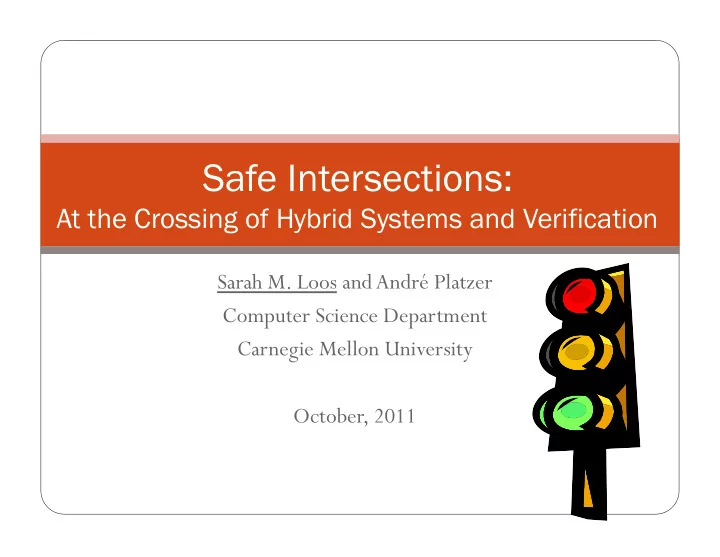

Safe Intersections: At the Crossing of Hybrid Systems and Verification Sarah M. Loos and André Platzer Computer Science Department Carnegie Mellon University October, 2011
Ultimately… 1/12
Simplifying Assumptions • Vehicles have positive velocity • Accurate sensing • Instantaneous braking and acceleration • Time synchronization • Delay for sensor updates is bounded • Straight lane dynamics • Cars represented as points, lanes as lines 2/12
Previous Work: Highway Control • Verified multilane highway system • Arbitrary number of cars • Arbitrary number of lanes • Proof of safety for distributed control built from two-car “building blocks.” 3/12
Intersection Building Blocks 4/12
Intersection Building Blocks 4/12
Intersection Building Blocks 4/12
Intersection Building Blocks 4/12
Intersection Building Blocks 4/12
Intersection Building Blocks 4/12
Intersection Building Blocks 4/12
Intersection Building Blocks This is similar to a merge on the highway. 4/12
T-Intersection Building Block 5/12
Intersection Building Blocks 6/12
Intersection Building Blocks 6/12
Intersection Building Blocks 6/12
Intersection Building Blocks 6/12
Straight Lane Building Block 7/12
Di Different ntial Dyna l Dynami mic L Logic * * * The he s sho hort v version. n. Initial Conditions → [Model] Requirements 8/12
Di Different ntial Dyna l Dynami mic L Logic Initial Conditions → [Model] Requirements 8/12
Di Different ntial Dyna l Dynami mic L Logic Initial Conditions → [Model] Requirements logical formula logical formula 8/12
Di Different ntial Dyna l Dynami mic L Logic Initial Conditions → [Model] Requirements logical formula logical formula 8/12
Di Different ntial Dyna l Dynami mic L Logic Initial Conditions → [Model] Requirements logical formula logical formula 8/12
Di Different ntial Dyna l Dynami mic L Logic Initial Conditions → [Model] Requirements logical formula hybrid program logical formula 8/12
Di Different ntial Dyna l Dynami mic L Logic discrete control continuous dynamics Initial Conditions → [Model] Requirements logical formula hybrid program logical formula 8/12
Di Different ntial Dyna l Dynami mic L Logic discrete control continuous dynamics → [(ctrl;dyn) * ] logical formula hybrid program logical formula 8/12
Di Different ntial Dyna l Dynami mic L Logic continuous dynamics discrete control → [(ctrl; x’= v; v’= a ) * ] logical formula hybrid program logical formula 8/12
Single Lane Stoplight To Prove: Initial Conditions → [Model] Requirements 9/12
Single Lane Stoplight To Prove: Initial Conditions → [Model] Requirements 9/12
Single Lane Stoplight To Prove: Initial Conditions → [Model] Requirements 9/12
Single Lane Stoplight To Prove: Initial Conditions → [Model] Requirements 9/12
Single Lane Stoplight To Prove: Initial Conditions → [Model] Requirements 9/12
Single Lane Stoplight To Prove: Initial Conditions → [Model] Requirements 9/12
Single Lane Stoplight To Prove: Initial Conditions → [Model] Requirements 9/12
Single Lane Stoplight To Prove: Initial Conditions → [Model] Requirements 9/12
Single Lane Stoplight To Prove: Initial Conditions → [Model] Requirements 9/12
Single Lane Stoplight To Prove: Initial Conditions → [Model] Requirements 9/12
Single Lane Stoplight To Prove: Initial Conditions → [Model] Requirements 9/12
Single Lane Stoplight To Prove: Initial Conditions → [Model] Requirements 9/12
Single Lane Stoplight To Prove: Initial Conditions → [Model] Requirements 9/12
Single Lane Stoplight To Prove: Initial Conditions → [Model] Requirements 9/12
Single Lane Stoplight To Prove: ✔ h Initial Conditions → [Model] Requirements 9/12
Intersection To Prove: Initial Conditions → [Model] Requirements 10/12
Intersection To Prove: Cars can stop initially Initial Conditions → [Model] Requirements 10/12
Intersection To Prove: No collision Cars can stop initially Initial Conditions → [Model] Requirements 10/12
Intersection To Prove: Cars can stop initially No collision Initial Conditions → [Model] Requirements 10/12
Intersection To Prove: Cars can stop initially No collision Initial Conditions → [Model] Requirements 10/12
Intersection To Prove: Cars can stop initially No collision Initial Conditions → [Model] Requirements 10/12
Intersection To Prove: Cars can stop initially No collision Initial Conditions → [Model] Requirements 10/12
Intersection To Prove: Cars can stop initially No collision Initial Conditions → [Model] Requirements 10/12
Intersection To Prove: Cars can stop initially No collision Initial Conditions → [Model] Requirements 10/12
Intersection To Prove: Cars can stop initially No collision ✔ h Initial Conditions → [Model] Requirements 10/12
Conclusions Future Work Curved road dynamics Distributed car dynamics Combinations of merge and cross protocols Noisy and delayed sensor data Delayed braking and acceleration reaction Non-synchronized time Non-zero car lengths and lane widths 11/12
Conclusions Cha halle lleng nges Solu lutions ns Infinite, continuous, and evolving We give a formal proof for a two-lane state space, R ∞ intersection with one car on each lane Simulation and testing only Semi-automated proof generation partially prove safety Variations in system design Continuous dynamics Demonstrated potential for formal Discrete control decisions safety verification in car control, even when models have high branching Large branching factor factor 12/12
Conclusions Thank You! 12/12
Conclusions Reference The full length paper for this research can be found here: Sarah M. Loos and André Platzer. Safe Intersections: At the Crossing of Hybrid Systems and Verification. In the 14th International IEEE Conference on Intelligent Transportation Systems, ITSC 2011, Washington, D.C., USA, Proceedings, 2011. 12/12
Recommend
More recommend